Discover all about the different types of eczema.
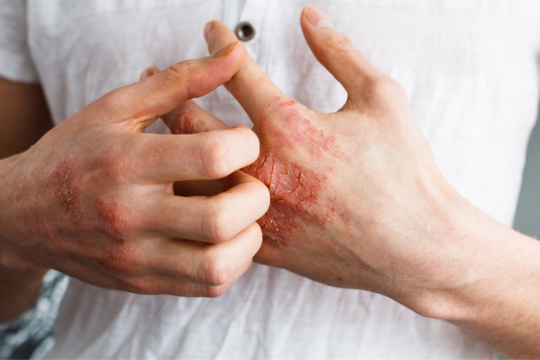
Eczema is a collective name for various skin conditions, in which your skin shows an inflammatory reaction. There are different types of eczema, each with its own characteristics and causes. That is why it is important to know which type of eczema you have, for an effective treatment.
Below we discuss the different types, in alphabetical order. Then we also touch on treatment options, and when it is wise to visit your GP.
Contents:
Acrovesicular eczema (vesicular eczema)
This form occurs mainly on the palms of the hands, fingers and soles of the feet. It is characterised by small, itchy blisters that can merge into larger blisters. The skin can then flake and become painful. This form is also called 'dyshidrotic' eczema or 'vesicular eczema'.
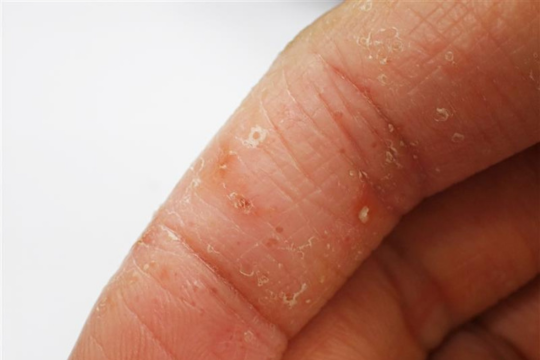
Known triggers for this type of eczema are :
Asteatotic eczema (craquelé eczema)
This form occurs mainly in the elderly and manifests itself in very dry, flaky skin that resembles cracked ground or porcelain. That is why it is also called 'craquelé eczema'.
It often occurs in the winter due to dry air and excessive washing. Age also has something to do with it. As you get older, your skin is naturally drier.

Source: Huidziekten.nl
Clown Eczema
Clown eczema is a type of eczema that you see around the mouth and on the chin. It mainly occurs in (young) women. This is because a reaction can occur to day or night creams that are often applied around the mouth. If you already have oily skin, the pores can become clogged more quickly.
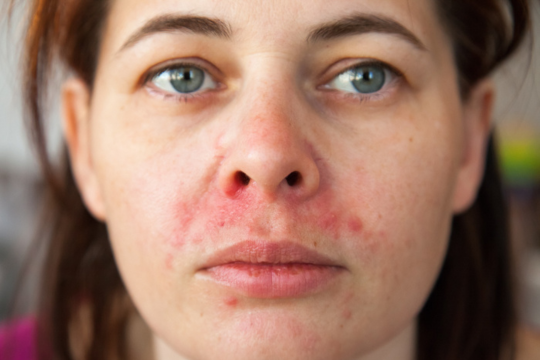
Another common cause of clown eczema is long-term use of corticosteroid creams. This can lead to a corticosteroid addiction. When you use a corticosteroid cream, the eczema calms down. If you stop using it, your eczema will get worse. You can get rid of this by switching to a weaker hormone ointment or by gradually reducing the use.
Corticosteroids taken in other ways, such as inhalers or nasal sprays, can also cause clown eczema.
Constitutional eczema (atopic eczema)
This is the most common form of eczema. It is also called 'atopic eczema'. It often occurs in families where allergies, asthma or hay fever occur. This form of eczema can develop at any age, but usually starts in early childhood.
The cause lies in your skin: if your skin barrier does not work optimally, you can quickly suffer from it. In addition, your immune system often plays a role. But, as you can read above, heredity also plays a (large) role.
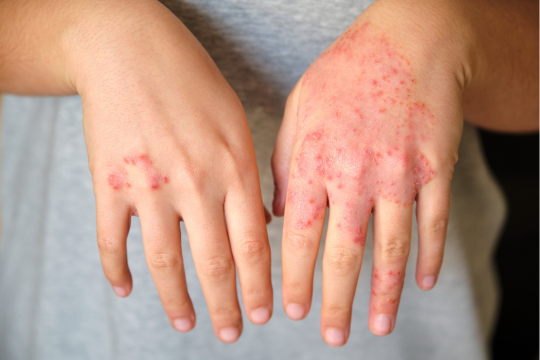
Features:
Atopic eczema often occurs in specific places:
Read more about atopic eczema →
If you have constitutional eczema, you can also find a lot of information and advice from professionals at eczeemwijzer.nl .
Contact dermatitis
With contact eczema, the skin becomes irritated by contact with certain substances. There are 2 types:
1. Allergic contact dermatitis
This is caused by an allergic reaction. Your body reacts strongly to substances that you are allergic to. For example, nickel in jewelry, certain fragrances or preservatives in cosmetics. The reaction often only occurs 24-48 hours after contact with the allergenic substance.
Common allergens include:
2. Irritant contact dermatitis
Also called 'ortho-ergic eczema'. This type is caused by irritation of your skin. For example, by prolonged or repeated contact with irritants such as water, soap, cleaning agents and chemicals. The reaction is visible immediately, unlike allergic contact eczema.
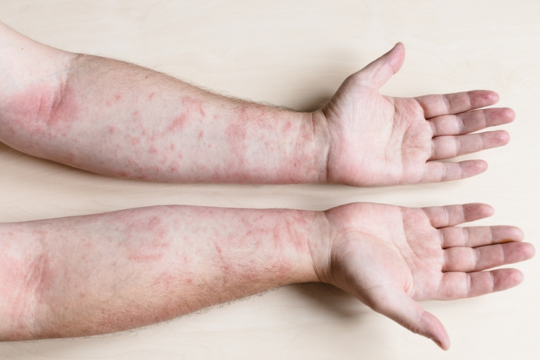
Read more about contact dermatitis →
See acrovesicular eczema (vesicular eczema) .
Hypostatic eczema
Hypostatic eczema is recognizable by redness, scaling and itching of the lower legs. It is often accompanied by varicose veins.
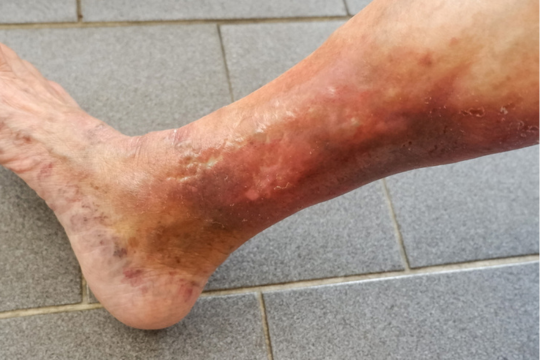
This type of eczema can occur if the blood in your legs is poorly circulated. Older people are particularly at risk.
Hypostatic eczema is also called 'orthostatic eczema' or 'stasis dermatitis'.
Intertriginous eczema is another name for sore spots .
Microbial eczema
This type of eczema is caused by a combination with a bacterial infection and is also called 'coccogenic eczema' or 'perifocal eczema'. The skin is then red, flaky and often wet.
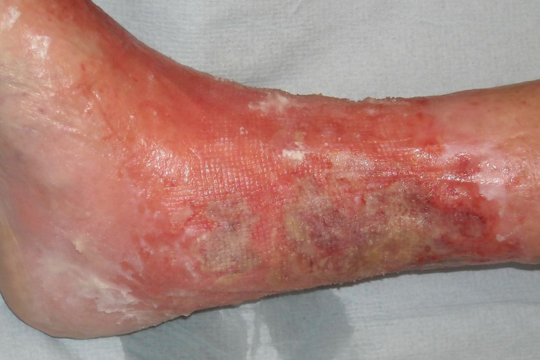
Source: Huidziekten.nl
Microbial eczema is common in people with constitutional eczema , because you are at high risk of such an infection.
Nummular eczema
This type of eczema is characterized by sharply defined, round or oval spots (often symmetrical) that resemble coins (hence the name "nummular").
The spots may be moist or dry, flaky and itchy. When these spots heal, they often leave scars.
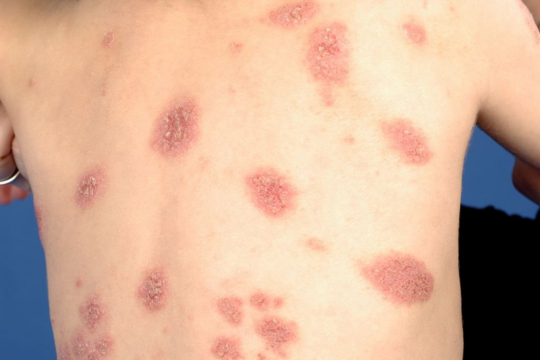
Source: Huidziekten.nl
The cause of nummular eczema is unclear. Atopic eczema may play a role.
Ortho-ergic eczema
See irritant contact dermatitis .
Seborrheic eczema
Seborrheic eczema mainly occurs in places where there are many sebaceous glands, such as:
Features:
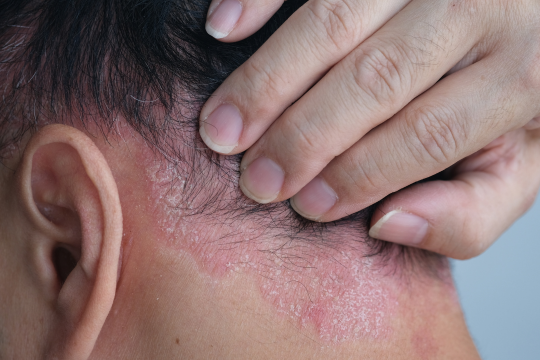
Seborrheic eczema is more common in:
Read more about seborrheic eczema →
This form occurs on the palms of the hands and the soles of the feet. You can recognize tylotic eczema by the thickening of your skin. You can also suffer a lot from painful cracks.
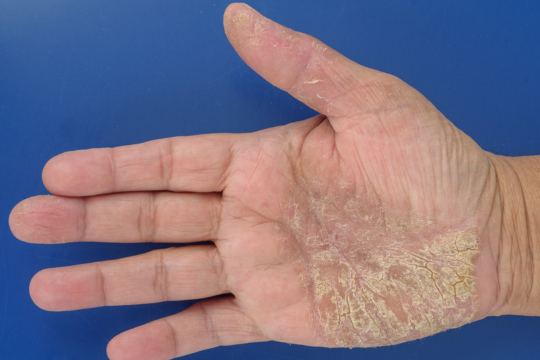
Source: Huidziekten.nl
This type is related to hypostatic eczema , because it occurs around varicose veins. Your skin is then red, flaky and often brownish due to iron deposits from the blood.
Swimmer's eczema
Contrary to what the name suggests, athlete's foot is not eczema. Athlete's foot is a name for athlete's foot. The treatment is therefore different from eczema. You do not use a hormone ointment, but an anti-fungal cream . Read more about athlete's foot and the treatment .
Treatment depends on the type of eczema you have and the severity of your symptoms. Sometimes eczema can diminish over time or even disappear (temporarily). But do you suffer from it (a lot)? Then the following general advice can help you:
View all products against eczema →
When is it wise to visit your doctor?
It is wise to visit your doctor if:
For severe types of eczema, various treatments are possible, such as:
You can do a lot yourself to prevent or reduce eczema symptoms:
Is eczema contagious?
People with eczema are sometimes afraid of infecting others, just as people without eczema can be afraid of being infected. This is not necessary, because eczema is not contagious at all. So shaking hands or hugging is fine. The skin is extra vulnerable, so don't be too rough with it.
Read more about the contagiousness of eczema →
There are many types of eczema, each with its own characteristics and triggers. Try to find out which type you have. Are you in doubt, is your eczema severe and does it bother you a lot? Then go to your GP for a correct diagnosis and treatment plan.
Regardless of the type of eczema, good daily skin care is essential to prevent and treat symptoms. With the right approach, most types of eczema can be kept well under control.